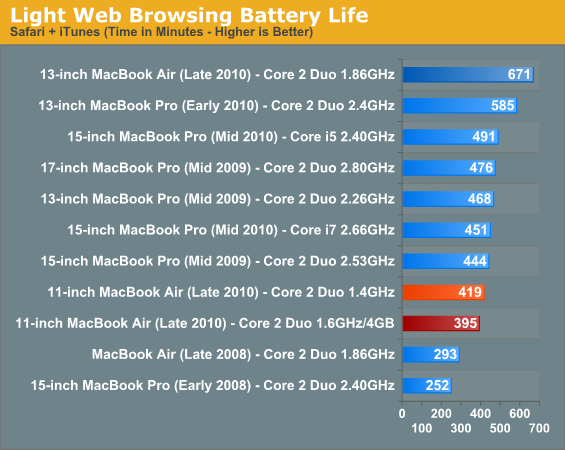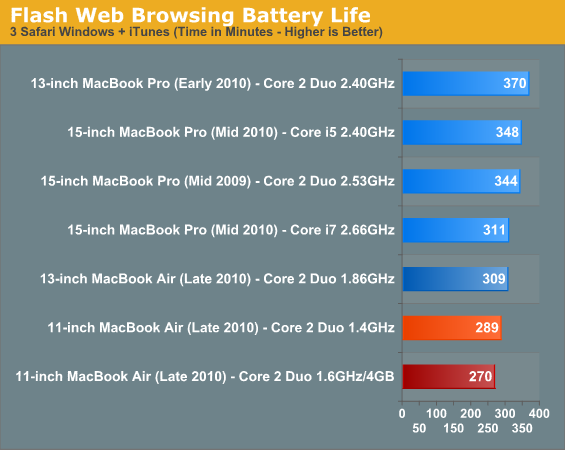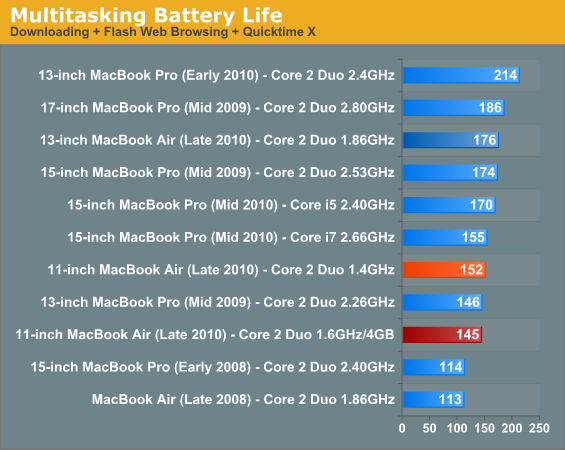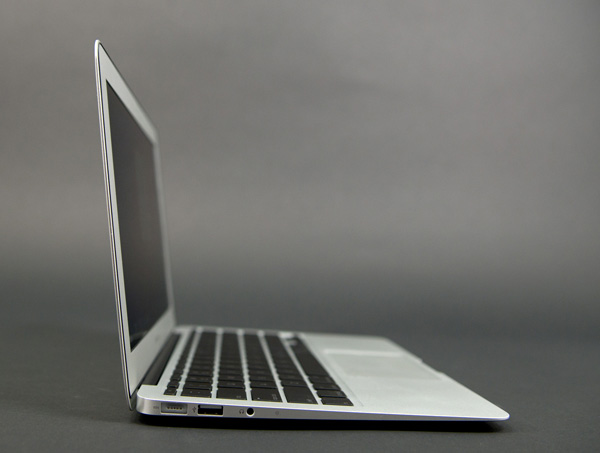Apple's 11-inch Upgraded MacBook Air: Do 1.6GHz and 4GB Make a Difference?
by Anand Lal Shimpi on November 6, 2010 2:35 AM EST- Posted in
- Mac
- Apple
- MacBook Air
- Laptops
Battery Life
Intel ships microprocessors, even those running at the same frequency, at varying voltages. Chips with lower leakage ship at lower voltages, while higher leakage chips ship at higher voltages. All CPUs have to ultimately fit within the same power envelope, but anything below that max TDP is fair game.
Running at a higher frequency generally requires a higher voltage, which in turn increases power consumption. I ran the upgraded 11-inch through all of our battery life tests to measure its impact.
Light Web Browsing
Here we're simply listing to MP3s in iTunes on repeat while browsing through a series of webpages with no flash on them. Each page forwards on to the next in the series after 20 seconds.
The display is kept at 50% brightness, all screen savers are disabled, but the hard drive/SSD is allowed to go to sleep if there's no disk activity. The wireless connection is enabled and connected to a local access point less than 20 feet away. This test represents the longest battery life you can achieve on the platform while doing minimal work. The results here are comparable to what you'd see typing a document in TextEdit or reading documents.

Flash Web Browsing
The test here has three Safari windows open, each browsing a set of web pages with between 1 - 4 animated flash ads per page, at the same time. Each page forwards onto the next after about 20 seconds.
As always, the display is set to 50% brightness, audio at two bars, screensaver disabled and the hard drive/SSD is allowed to go to sleep if idle. The wireless connection is enabled and connected to a local access point less than 20 feet away.

Multitasking Battery Life
Our final battery life test is the worst case scenario. In this test we have three open Safari windows, each browsing a set of web pages with between 1 - 4 flash ads per page, at the same time. We're also playing an XviD video in a window all while downloading files from a server at 500KB/s.

Overall the upgraded hardware resulted in a minimal impact to battery life. The worst impact was in the Flash web browsing test in which the upgraded system delivered 93% of the battery life of the base 11-inch MBA. The remaining two tests offered between 94 - 95%.
Given the 15% average improvement in performance when you need it, a 6% average reduction in battery life isn’t bad.











85 Comments
View All Comments
khimera2000 - Saturday, November 6, 2010 - link
the only portable i would try it on is a M11x (core2) it can overclocked out of the box, and was disinged to stan higher thermals then the core2 for future upgrading (hello i7 ).Looking at the 11 inch mac book there is not much for heat disipation when you get down that thin. according to intel's web sight the 1.4 and 1.6 variant have the same TDP so overclocking the 1.4 might make more heat then the 1.6.
then again it might make an intresting test to see if that is in fact true.
tehjord - Saturday, November 6, 2010 - link
Has it really? Because I mean, it must be the same piece of silicon by now, perhaps in the past with bad yields, but today, these are very old cpu.khimera2000 - Saturday, November 6, 2010 - link
this is true that is probably a more refined fab, but the issue i have is that the mac book is uber thin, I have no idea if they took this into account in the desing, and i have no idea how it will effect the heat issues. I overclocked one notebook and found that it got so hot my SD card in the memory slot melted.Over clocking a notebook is not worth it to me. it will void a warenty and if something goes horrably wrong you still have to spend the full cost to replace the system, where as a DeskTop you can test components and salvage some of the components.
kmmatney - Saturday, November 6, 2010 - link
Can you overclock a Macbook air? If so, then that would be the way to go. Googling found this:http://www.coolbook.se/CoolBook.html
StormyParis - Sunday, November 7, 2010 - link
I don't understand how you can call such a glossy display "good". I would never, ever consider buying laptop with a mirror in place of a screen. Apple should at least offer a mate screen as an option.sa7078 - Sunday, November 7, 2010 - link
I just upgraded from a late 2008 1.86 Air to a 2010 11" 1.6 ghz/4GB Air. While the new model may not match the old one it terms of raw CPU power, what most reviews, including Anandtech, are leaving out is that the old Airs got very hot, slowed down to cool down and vented constantly out of the bottom of the unit. This made them impossible to use on a bed and they frequently throttled back the CPU to cool down. They also struggled to play video. The 2010 model has no vents, runs very cool, and plays any video I've thrown at it, including Sling HD, which halted on my old Air. So the new Airs may not be the best choice for people who run processor intensive apps like Photoshop, but neither were the old Airs. And the new ones are simply a million times better at common tasks like Web video, word processing, email, etc. Simply put, the new 11" Air is the best laptop I've ever owned -- it just works. The old one was cool and light but it got too hot and couldn't run some of the most simple tasks like video, because of an old video subsystem and a constant need to cool down.johnspierce - Sunday, November 7, 2010 - link
I would love to see performance comparisons between a Macbook Pro 13" 2.4ghz with an SSD in it.- Compare it to the two MBA's
- Compare it to the MBP 13" stock
- Compare it to the MBP 15" with i5 and i7
I'm betting it will perform at least as well as the 15" i5 and more likely will be *almost* as good in overall performance mix as the i7.
This could be the "sleeper" best deal for your money in a Mac notebook. Considering you can buy 128gb SSD's for under $200 now and Microcenter in Denver sells new MBP 13" for $999.
You guys at Anandtech should do this!
thanks for the articles, your stuff is my favorite!
John
Jon03021 - Monday, November 8, 2010 - link
I second this!rgslater - Sunday, November 7, 2010 - link
Way overpriced for me. The hardware is on par with the Acer Timeline 1810t (11", C2D, 4GB) that I bought over a year ago....for about $550. Where is the Timeline now?.......Core i7 ULV (1.46 GHz, turbo to 2.53 GHz)
4 GB ram
500 GB HDD
more connectors (3 usb, HDMI, VGA, card reader)
8 hrs battery life (claimed)
Its a bit pricey at $849 (Newegg) but still far less than even the base model Mac. And the prices only go down from there, because you can choose from i5 and i3 processors as well.
Sure it has some limitations, like the graphics. It's roughly the same dimensions, but half and inch thicker and about 12 ounces heavier. I guess that's why it isn't "portable perfection".
As much as I don't get their products...actually I get the products, but not the pricing...I have to admire the company. They somehow make otherwise objective tech writers get misty-eyed over old tech at inflated prices.
And the transmeta analogy is a non starter. Why does that even matter? Everything in tech has gotten cheaper. The fact that I paid $3000 for my first desktop (486) does not make me think that anything less than that today is a good deal.
MacTheSpoon - Monday, November 8, 2010 - link
If it had a matte screen and battery life equal to the Vaio X, I would switch over. As it is, I'll stick with my Vaio X. Though honestly, if you're just writing and browsing the web like me, an Asus netbook these days is a fraction of the cost of either computer, has a matte screen, and its battery life is not quite up to the Vaio X but it's getting up there. The keyboard and screen are a little smaller than the MBA 11" and it's a tiny bit heavier, but really overall it's a great way to go.